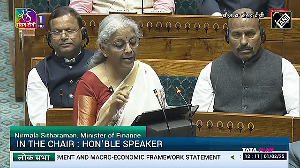India's fashion designers need to think like a business manager while being creative and a marketing genius, if they want companies to invest in them.
That's the message for designers from Darshan Mehta, president, Arvind Brands.
At the fourth FDCI - DHL 'Business of Fashion' seminar at the Lakme India Fashion Week with Liberty 2003 (LIFWL 2003), Mehta said, "For a designer to grow, the designer needs to think like a business manager, incorporate consumer feedback, have an efficient supply chain management system and stringent quality control for large scale manufacturing. At the same time the design label needs to retain the snob appeal even when it goes mass and ensure there is a freshness in the line over seasons."
Mehta underlined one point: "Business is where the mass is."
Arvind Brands recently added the 'Tommy Hilfiger' brand to the Arvind stable of brands and Mehta provided some valuable insights into the Indian corporate mindset vis-a-vis designers.
He said, "Any corporate looking at investing in individual designers looks for consistency, a good business partner and creativity within a structure."
Mehta cited Tommy Hilfiger as a case study, He spoke about the process and efforts that have gone behind building a successful label such as 'Tommy Hilfiger'.
He described Tommy as "the designer turned corporate maverick with a great business sense and the ability to institutionalise creativity and broad base. Tommy Hilfiger is a story of creativity, brilliant marketing, fame and big money. The business of Tommy Hilfiger has move from spectacular design to marketing. The success is attributed largely to delivering what consumers want."
Describing the changing face of the Indian fashion environment he said that the Indian consumer has become highly fashion conscious and has an increasing disposable income.
The new age Indian designer is moving away from just being a Page 3 persona to corporate savvy brand builders. Fashion is moving from glamour based interaction to a more business type one.
Fashion is a serious business. The number of buyers for pret collections have increased and retail stores of fashion designers are doing roaring business.
Mehta said, "Fashion in India is a Rs 250 crore (Rs 2.5 billion) business, it has the potential to be Rs 300 crore (Rs 3 billion), based on 5 per cent of the apparel market. Also, 80 per cent of the Rs 250 crore (Rs 2.5 billion) market is bought by Indian consumers. The future of fashion lies in pret and diffusion lines. But the challenge lies in transforming individual designers into multinational corporations."
Already, a beginning has been made with Raymonds taking the initiative to launch the BE store which houses 13 designer labels and is making fashion affordable and more accessible.
There is interest in collaborations. Jet Airways has designer label uniforms. More and more companies are expected to invest in designer labels and take them forward.
In sum, Mehta said, a sound business sense, institutionalising creativity, the right environment, broad basing -while retaining snob appeal are the keys for corporates to invest in designers.






 © 2025
© 2025